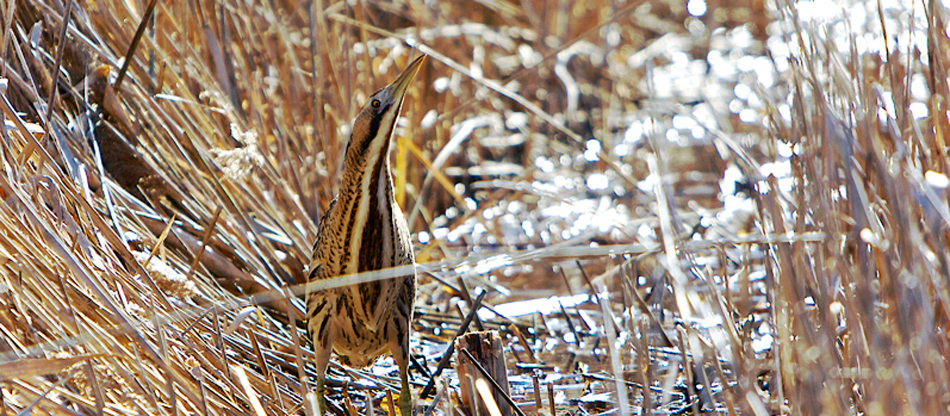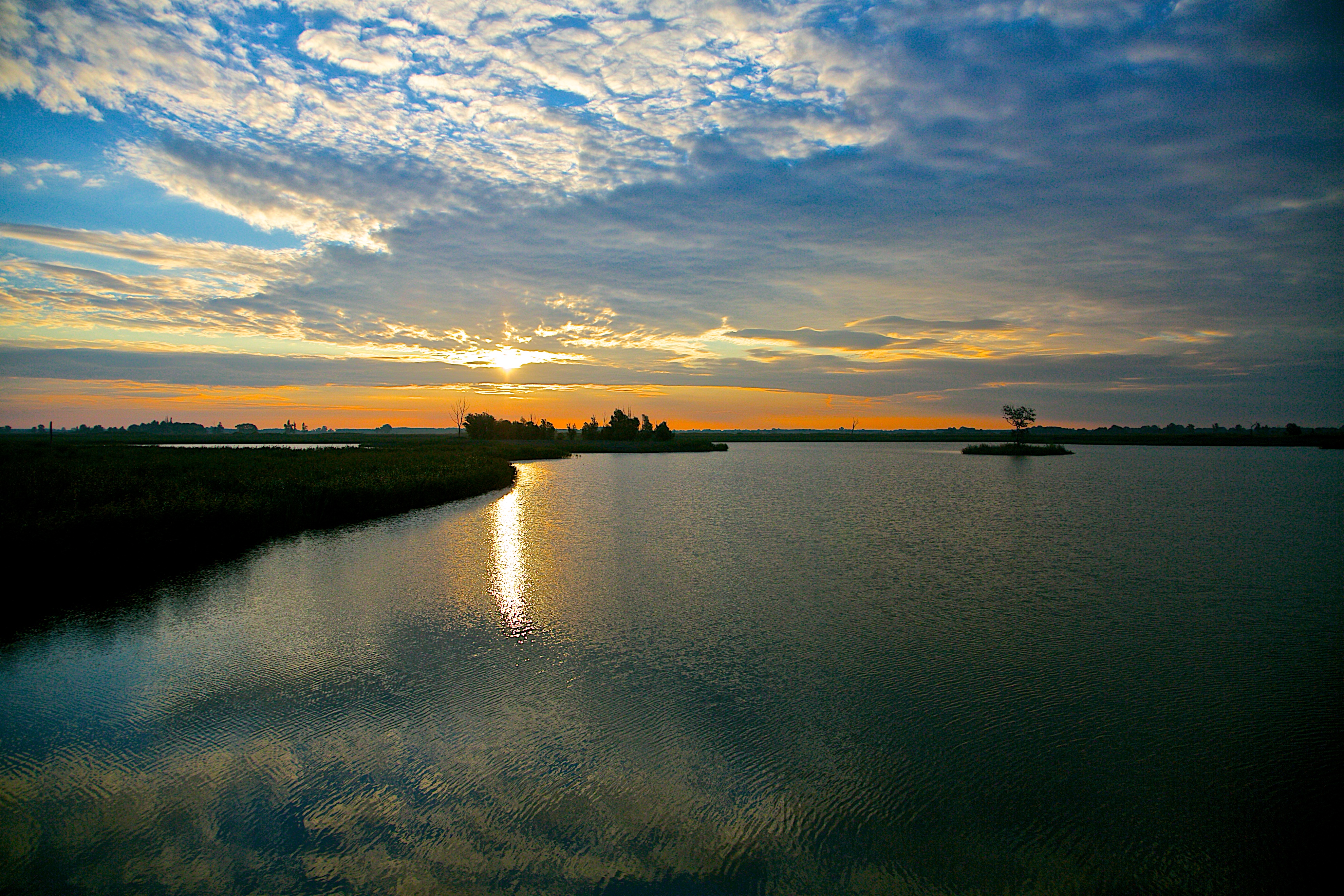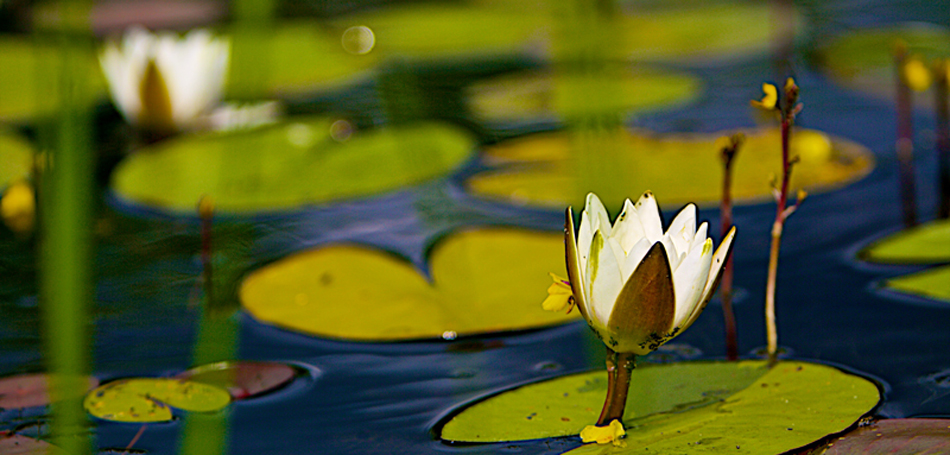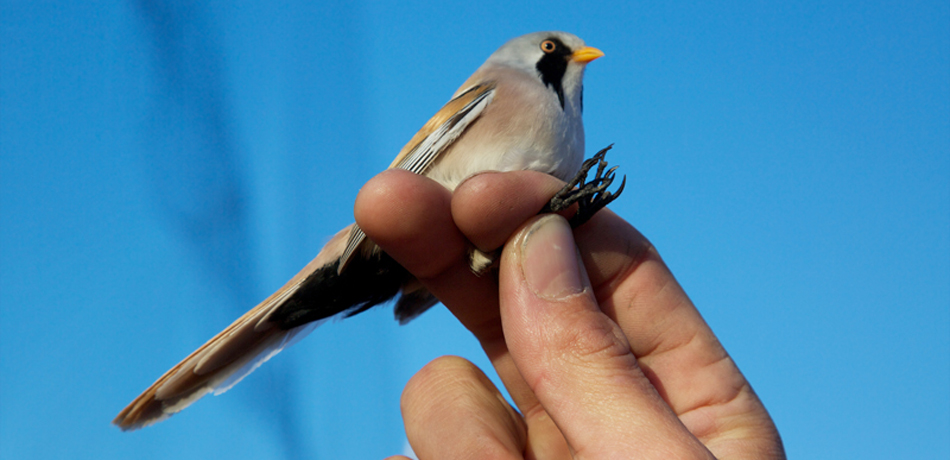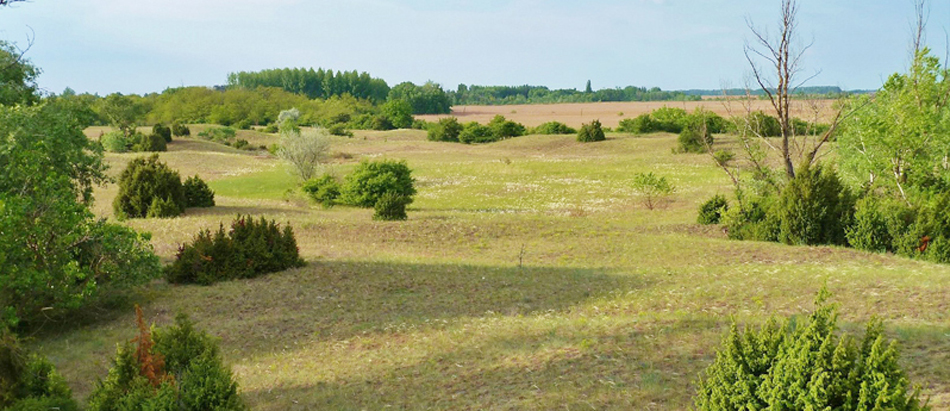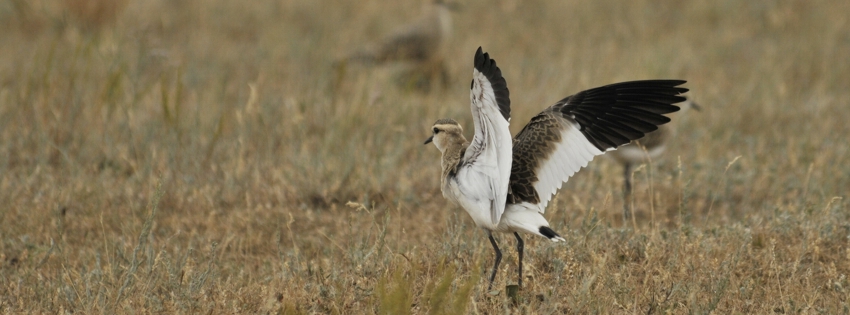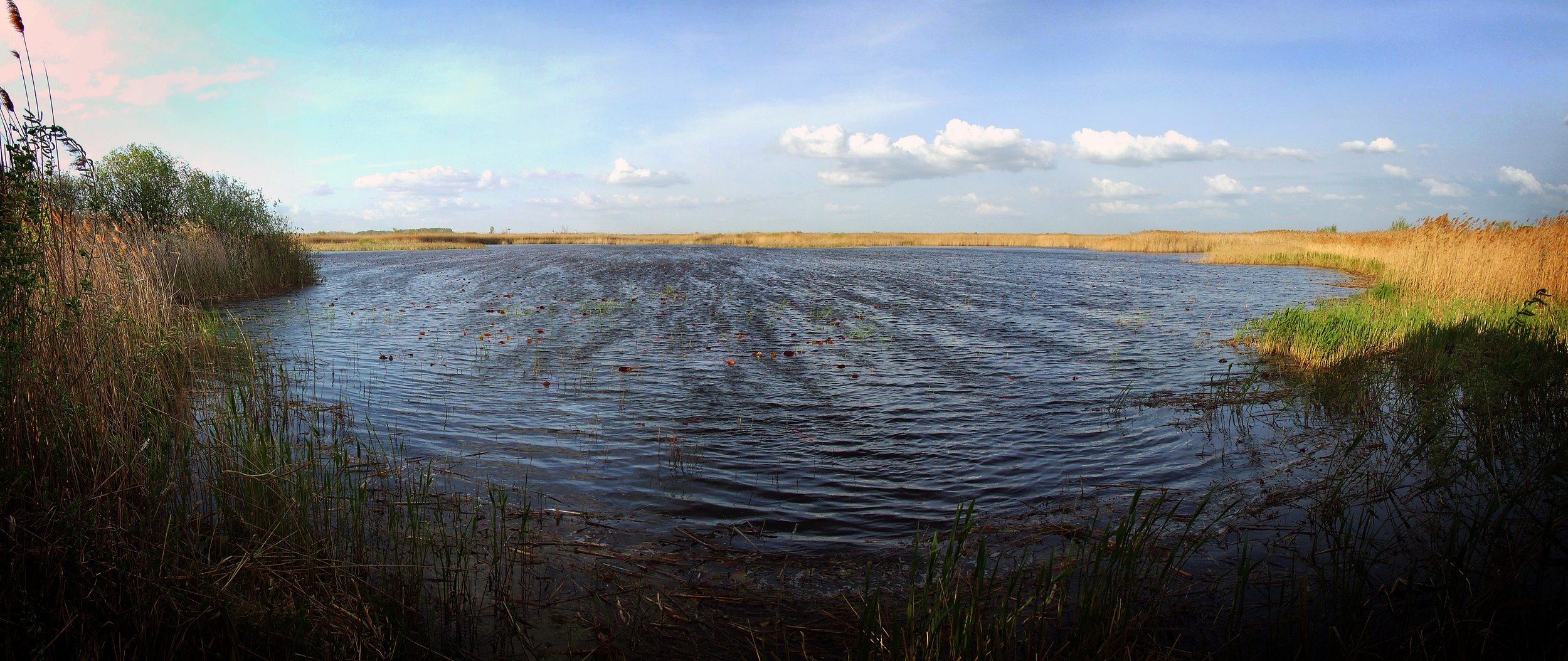National park
Drilled cores show that Kolon lake was formed between 35 000 – 12 000 years ago, during the Würm ice age. The lakebed was formed from a fragemented branch of the Danube basin. Changes in the hydrogeological character of this former section of the Danube river enabled the movement of driftsand during the middle of the Würm period, so that the northern section of the lake was filled with it. Later the lakebed’s water level significantly increased, resulting in silt deposits. Until the end of the Pleistocene period, few carbon-rich silt layers were deposited. With the global warming that started around 11 000 years ago, cold-adapted plants (e.g. pines) decreased in number and later completely disappeared. Around riparian areas, soft- and hard- wood forests grew, such that at the start of the Holicene period the dominant species were oak and hazelnut trees.
Between 9-5000 BC the lakebed filled relatively quickly, and a marshy ecosystem was established. On the basis of 5000-year-old beech pollen grains, beech forests were present in the riparian zone. In the modern age, agricultural systems replaced the beech forests and extensive open grasslands developed. Weeds became established, and there is evidence for grain cultivation from this time. From the Iron Age (8th-1st century BC) to the end of the Middle Ages, arboreous vegetation ceased to exist around the Lake, and the Lake’s environment came under the control of humans.
Kolon Lake was divided in the north-west when the railway line between Kecskemét and Fülöpszállás was built in 1895. In 1912 the main Danube-valley water channel was built, with the aim of turning the marshes into agriculturally productive areas. The people of Izsák protested against the planned draining of Kolon Lake in 1922, however the draining went ahead in 1927-28 nevertheless. As a result the water level significantly decreased, which led to the decline of nearby vineyards and orchards. Reed-cutting and fishing, from which many people made a living, came to an end. During the 1940s the fauna and flora of the rush- and reed- beds also disappeared.
During the second world war the water channels were neglected, and the Lake was able to regrow into a healthier state. Peat bog exploitation occurred in the area between 1952-55: it came to a quick end as a result of the rising water levels as well as the poor quality of the peat. Although the Lake regenerated over time, traces and scars of human use and impact were not so easily erased.
Kolon Lake has been a part of the Kiskunság National Park since 1975. The dam (called the Alsó-Matyói dam) that crosses the lake from east to west was heightened in 1981, with the aim of increasing the Lake’s northern water levels so that optimal environmental conditions would exist for water-dependent life during dry periods.
2784 hectares of the Kolon Lake are protected, of which almost 1500 hectares are reed-beds. The protected areas are surrounded by four settlements: Izsák, Páhi, Csengőd and Soltszentimre. To the north-east there are salty marshes that are used for making hay and the grazing of gray cattle. To the south invaluable and biodiverse wildlife can be found in semi-arid marshland, while to the west the Lake is bordered by steep sand-dunes. The Lake today is fen-like, in which the reed-beds are dominant species. Reed-beds are endangered and protected ecosystems in Hungary.
European white water lilies (Nymphaea alba), water soldiers (Stratiotes aloides) and many pond-weed species grow on the open water surfaces. The uniform reed-beds are broken by grey willow trees. Rich invertebrate fauna give sustenance to the Lake’s amphibians, fishes, reptiles and birds. There are significant numbers of European weatherfish (Misgurnus fossilis) and European mudminnow (Umbra krameri) in the Lake. Otter can also be found around the dam.
A few hundred years ago the landscape between the Danube and Tisza rivers was made up of undulating, forest-less sand dunes. Due to over-grazing in the 18th century, the sand dunes started to erode away, changing the physical location of the dunes. The free-moving sands resulted in large sand storms during the 1800s, which gradually made life intolerable for the people of this area. Finding a solution to this problem became vital, but for a long time plantations were only experimented with. Black poplars (Populus nigra) were found to be appropriate to the area, and for a century these trees were planted. To the end of the 19th century, only small areas were planted with trees. The middle of the 19th century saw the widespread rise of farming, such that croplands replaced grazing land, and in flatter areas vineyards and orchards were established.
Acacia plantations were planted at this time. As grazing was still very important to the area, permanent sand dune vegetation was very slow to become established. In 1949 there was still almost 7000 hectares of drift-sand between the Danube-Tisza.
The landscape was dramatically altered during the 1950-60s, when small-hold farmers were replaced by large commercial vineyards and plantations. This predominantly resulted in the bulldozing of large areas of sand dunes. The official forestry regulations dictated that areas that were not agriculturally viable had to be converted to plantations, thus the ‘value-less’ sand dunes were covered with black and Scots pine. At this point in time the initial goal of tying down the drift-sand was fulfilled, however the plantation pines did not bring any of the anticipated commercial gains, hence the work in their upkeep was deemed not worthwhile.
The sand dunes surrounding Izsák were forested in the late 1970s, replacing many vineyards. Kolon Lake and the remaining sand dunes and grasslands have been protected and a part of the Kiskunság National Park since 1975. Unfortunately on private holdings plantations still occur with non-native species, as forests of black pine and fast-growing poplar clones are very common.
Very few pristine sand dune areas exist today as a consequence of the establishment of plantations.
This farmstead was built in the early 1900s by the Kecskemét-born barrister Vidor Angyal, and once included several other buildings, including a barn and a basement. The farm was made up of 10 acres of vineyards and 60 acres of cropping land, which were used for orchards, fields or for grazing. The farm changed ownership several times, and became run-down during the second world war, when the ‘Hubertus’ Hunting Club of Izsák purchased it. After a member of this club bought the property and renovated the farmstead, it was sold to the Kiskunság National Park in 1999 after a series of break-ins. The National Park continued the buildings’ renovations, connected it to the electricity grid, and in 1999 established the Kolon Lake Bird Ringing Camp.
Standardised migration and breeding songbird monitoring commenced with the establishment of the Camp. Every year, birds are trapped in nets and ringed with exactly the same methodology and techniques, in precisely the same areas. Songbirds are trapped with mist nets. Trapped birds are ringed on their left leg with an aluminium serial-numbered ring, on which ‘BUDAPEST’ is written. After the identification of the birds, their condition is evaluated, which is all recorded. This data is sent to the Hungarian Bird Ringing Centre in Budapest. Such long-term data collection means that changes and trends in migration patterns, habitat use and flight patterns can be detected. In this Bird Camp between 15-30 000 birds are ringed per year, and between 3-5000 birds are recaptured. The Kolon Lake Camp holds a Hungarian Bird Ringing record: a white stork that was ringed here was recorded 8963 kms away in South Africa, which is the longest distance a ringed bird has ever been detected to fly from Hungary (yet).
The emblem of the Bird Camp features the rare moustached warbler (Acrocephalus melanopogon); the largest number of breeding pairs are found at Kolon Lake. Our research is focussed on the protection of these endangered warbler species, whereby we also receive support from other south-European research stations.
The Bird Ringing Camp receives several hundred vistors per year, including groups of school children. These groups are initiated into the world of birds and ringing, contributing to their understanding and appreciation of the environment and the importance of conservation.
The area between the Danube and Tisza rivers are predominantly covered by sand dunes, which arose during the last Ice Age when wind mixed aeolian soil with sediment from the Danube.
The Bikatorok region is made up of sand dunes that stretch for 12 km: its widest section is 4km long and its highest point is the 122 metre high Reveckei Dune. The Bikatorok Dune (117m) rises immediately from the edge of the Kolon Lake lakebed. The sand dunes around the Lake were flattened for the establishment of non-viable forest plantations, and the areas that remained were predominantly used for vineyards and orchards. Only the very steep, agriculturally non-viable sandy hillocks remained in their original state. Within the plantations the native steppe plants completely disappeared, as the planted acacia and pine forests changed the chemical composition of the soil. Aggressive non-native species invasions have led to the formation of diversity-poor ecosystems (composed of, for example, the Common Milkweed (Asclepias syriaca), Horseweed (Conyza canadensis) and the Common Ragweed (Ambrosia artemisiifolia). Areas that have been left uncultivated for 10 years have seen the return of several protected species (for example the Late-Coming Carnation, Dianthus serotinus).
The perennial feather grass-covered (Stippa spp.) dunes are rare, native and valuable. Semi-arid plants have colonised the sandy soils, which do not retain much water and have small quantities of humus. On the sandy steppes protected, native (endemic) and primeval plants can be found (for example Tragopogon floccosus and Dianthus serotinus). Unfortunately the sand dunes have weathered over time, including from over-grazing, such that its condition today is poor.
Plants have many strategies to cope with periods of drought over summer. Many annual plants (e.g. Wild Rye (Secale sylvestre)) germinate in the autumn or early spring, and in the early summer they go to seed. Perennial species have a thick, deep-growing primary root which reaches into the groundwater (e.g. Dyers’ Bugloss (Alkanna tinctoria)).
Even though these regions are now protected, continued human use and impact erode the sand dunes and its biodiversity. Military exercises have been held in this area for many years. This affected the landscape through the introduction of foreign chemicals and intensive land use, degrading some areas, while others were fenced off and remain pristine. The tracks of motor- and quad- bikes are so deep in some places that rainwater collects in streams, which leads to the continual washing away of sand. These eroded, trampled dunes then become suitable habitat for invasive plants, which out-compete the precious native species.
Kiskunság National Park Full day
Kiskunság National Park Full Day [...]
Kiskunság National Park Half day
Kiskunság National Park Half Day [...]
Morning tour to the bird station
In the heart of the national park around the [...]

